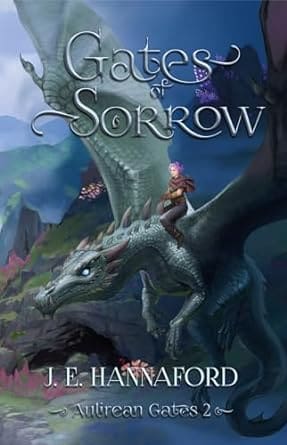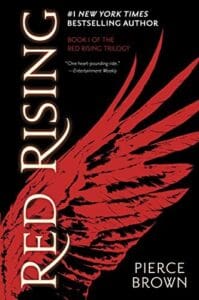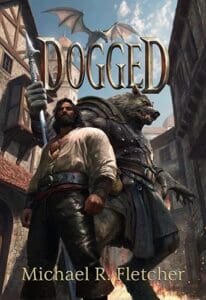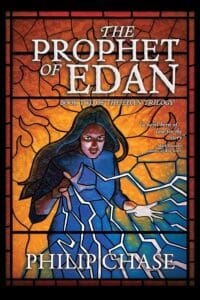
Why choose between dragons or dogs when you can have both?
Synopsis
Deep beneath the Black Palace in Lieus, Suriin pays the price for trusting Natke. Cut off from her magic and unable to rescue herself, she waits on aid from Darin and the Howlers. The cost of her rescue? The future she’d always dreamed of.
Thanks to Darin and Chase, the Howlers’ access to magic is no longer restricted, but as they prepare to hunt down the xotryl and its new companion, they receive disturbing news from Dal. Natke is hunting. She will stop at nothing to get home to Tebein.
Far away, on Tebein, Elissa’s only hope to rescue her people is to travel to the moon of Mythos and find a way to re-open the Aulirean Gate on Lieus.
Review
Gates of Hope, Book 1 of the Aulirean Gates series released last year, introduced us to a classic, old school epic fantasy adventure with a modern sheen. Filled with Hannaford’s patented skills of combining astonishing worldbuilding with character-driven, tear-jerking, found family fantasy, it gave us a world, Caldera, that was once connected to two others via magical gates. Following a brutal war with an alien race, these gates were sealed by magic dragons (more on these odd guys later) seeking to avoid bloodshed. Now, centuries later, the powerful magic users who battled these aliens have had their powers limited to practicing more subtle sorcery, the magic powers divided between women and men to reduce their world-ending potency. Meanwhile, on the nearby planet Tebein, a human colony left trapped after the gates closed are hunted by the aliens.
Book 1 was a fairly slow affair, but in the best kind of way, as we were carefully introduced to the incredibly detailed and inventive magic systems, the secret lore and history of the world, drip-fed like puzzle pieces, and the three main young character POVs, all discovering their own kinds of magic, finding their own found families, and slowly facing up to the renewed threats to their world from the return of the aliens. Oh and it gave us the best animal companions ever, more on that in a moment.
Book 2 rewards our patience by launching us straight into the action. We open where we left off in Book 1, with the consequences of its dramatic ending being played out in real time, as our young protagonists hurry round the secret passages of their hideout trying to prepare to fight the new threat with old magic without alerting their sceptical superiors.
One of the most impressive things about this series is the magic system – technically magic systems – which are revealed to have even greater depths in this sequel. I count about three branches of the magic in this world, and each one could have a claim to being the most inventive you’ll read in a fantasy book this year. The “singing to do stuff” system (not what Hannaford calls it, thankfully) continues to be used intriguingly, including an amazing scene of an amputation where healers combine their melodies to keep the sickness at bay.
Then there’s the emotion-based system used by the female magic users, who can direct their feelings out to people, and if that sounds like giving them a raw deal, then you should understand how fascinatingly powerful this makes them, including a brilliant twist in this book of emotions being threaded onto weapons to make them more deadly.
The magic system that in many ways defines this book, however, is the moonhounds – magical dogs who can telepathically communicate with their owners though mental images as well as walk in their dreams. Aside from the endlessly fascinating way they communicate, Hannaford kicks the ball very squarely into the open goal of tear-jerking potential here by making the bonds between the dogs and their owners something that will hit dog lovers extremely hard in the feels. One character forges a bond with an aging sick dog and oh, my easily led heart.
And of course I have to mention the dragons – again, Hannaford’s marvellous inventiveness is firmly on display here as we have dragons that literally represent emotions – hope, sorrow, anger etc. These new characters are a joy, as they are at once bizarrely inhuman yet also Hannaford gives them some of the best comedy lines, making them pretty hilarious at times as well as breathtakingly mysterious. We get to see their home world in this book too, and it is as strange as you’d hoped.
But ultimately, for all the magic goodness, Hannaford’s real weapon here is her Robin Hobb-like ability to focus the narrative on her characters: their dark journeys, their impossible decisions and the found families along the way. This is character-driven fantasy at its best, simultaneously cosy at times (man do I want to be a member of the moonhound pack the Howlers) while also being wickedly dark and traumatic for its characters when it needs to.
While the middle of the book returns us to the slower pace, allowing us to wallow in the glorious inventiveness of the magic and the cosy found family vibes (now including between dragons and humans), the last 100 pages once again takes us into the thick of the action and raises the stakes even more, leaving me more keen to get book 3 than a barefooted Arctic explorer is to find a pair of slippers.
This is superlative, deeply moving character-based epic fantasy with a magic system I could watch five Netflix series on. I cannot recommend this series enough.








Leave a Reply